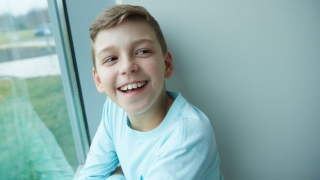Food Allergy Bravery Clinic
 Nearly 1 in every 13 U.S. children has food allergies. While living with a food allergy is challenging for many children, for some the fear of anaphylaxis becomes overwhelming, causing them to lose interest in typical activities and retreat into their own “safe” world. When asked, some families dealing with food allergies rank their child’s quality of life worse than if their child had a chronic illness like diabetes.
Nearly 1 in every 13 U.S. children has food allergies. While living with a food allergy is challenging for many children, for some the fear of anaphylaxis becomes overwhelming, causing them to lose interest in typical activities and retreat into their own “safe” world. When asked, some families dealing with food allergies rank their child’s quality of life worse than if their child had a chronic illness like diabetes.
At Children’s Hospital of Philadelphia, we’ve seen an increasing number of allergy patients with anxiety so severe it is preventing them from enjoying life. The Food Allergy Bravery (FAB) Clinic was created to identify and support this special population of children.
Program developed to meeting patient needs
The FAB clinic was started in 2018 as a collaborative project between a nurse practitioner, physician and psychologist with a special interest in food allergy anxiety.
Initial results were promising, and the growing clinic received additional funding to become a permanent addition to the Food Allergy Center. Clinic leaders developed a new screening tool to measure food allergy-related anxiety and a treatment manual for patients to address that anxiety and related fear of anaphylaxis. Today, all patients seen with food allergies at CHOP are screened for anxiety and referred to the FAB Clinic as needed.
About the FAB Clinic
When children with excessive anxiety about their food allergies are referred to the FAB Clinic, families complete an intake visit where our team discusses:
- The child’s food allergy history from diagnosis to today
- The frequency and severity of adverse reactions experienced, and
- The impact the child’s food allergy has on their daily life, including mealtimes, social events and gatherings.
Then, our team develops an individualized, cognitive behavioral treatment program that includes repeated “brave practices” to encourage your child to take small steps towards facing their fears and building their confidence around food and social situations.
For example, a child with an allergy to peanuts, may practice being in the same room as a person eating a peanut butter sandwich, then move closer to be at the same table, then sit next to that person – each time getting physically closer to their allergen without having an allergic reaction. Other brave challenges may include smelling the food allergen, touching it (followed by hand washing), or trying new allergen-free foods.
We spend time on psychoeducation and reviewing terms that may be confusing for children and many parents including food labels that say “may contain” or “shared equipment” or “made on the same line.” We discuss risk assessment and the likelihood of an allergic reaction in each situation to make sure children and their families have accurate information about adaptive caution and unnecessary avoidance.
We also provide patients with tips and tools they can use to keep themselves safer including avoiding cross-contamination from serving utensils, and learning how to approach workers in restaurants or cafeterias to ask if any prepared food contains their allergens or was cooked on a shared surface. Families complete therapy homework between cognitive behavior therapy-based sessions to reinforce gains in “real world” settings.
After about six sessions, participants “graduate” from our program and are better prepared to enjoy life and are not driven by fear of their food allergies.
Scales of Food Allergy Anxiety (SOFAA)
Researchers at CHOP have developed a new scale specifically to measure food allergy related anxiety in children. The tool, called the Scale of Food Allergy Anxiety (SOFAA), was developed in partnership by medical professionals in CHOP’s Food Allergy Center and a cognitive-behavioral psychologist specializing in pediatric anxiety, in consultation with parents of children with food allergies. Learn more about the tool.
Contact us
For more information, contact us at FoodAllergyBravery@chop.edu.